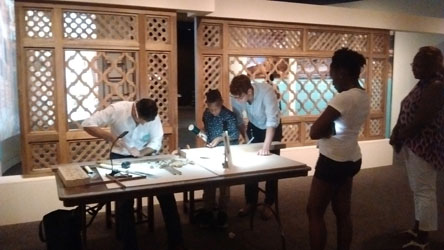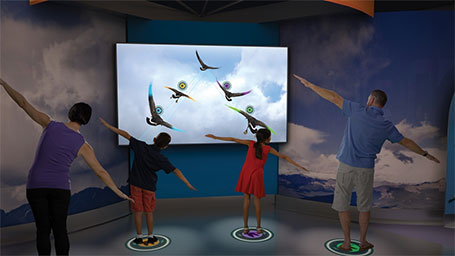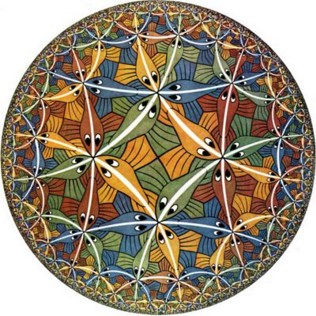Prior Projects
SOAR has worked with many of the Smithsonian's art, history, and science museums, as well as the central administration and offices, research centers, and mission-enabling units. We have done projects with large and small budgets, using a wide range of industry-leading research methods. Some illustrative projects include:
Turquoise Mountain: Artists Transforming Afghanistan Exhibition Evaluation
Client: The Sackler Gallery

Project Description: SOAR conducted an evaluation of a popular exhibition at the Sackler Art Gallery that used a multi-modal methodology. This evaluation included:
- entrance and exit surveys conducted both when artisans were creating crafts within the gallery space and when artisans were not present,
- visitor observations paired with a short survey, and
- visitor interviews—again conducted both during artisan present and no artisan present conditions.
SOAR found that the visitors to the exhibition had their positive perception of Afghanistan and their estimation of Afghan goods’ quality grow. When an artisan was present in the gallery, those visitors either watching or speaking with the artisan were twice as likely to rate the exhibition Superior, than those visitors who did not have an artisan encounter. Ultimately, this work was used to determine that the exhibition met and exceeded the Sackler's goals for it.
The Collections Policy Report
Client: Office of the Secretary of the Smithsonian

Project Description: Our collections policy study (see the report, “Concern at the Core”) involved a comprehensive, in-depth look at collections management across all Smithsonian SD600 collecting units. It explored the history and philosophy of collecting at the Smithsonian, as well as current strengths and weaknesses in the areas of collections planning, care (including documentation), staffing, space, access, and development. To the extent possible, SOAR quantified the resources allocated to collections management.
The single most important finding was a downward trend over time in staff resources for collections management, which constrained the ability of some units to adequately care for their collections. One of the recommendations led to Congressional funding of additional collections management staff.
The Quarantine Process Project
Client: The National Zoological Park (NZP)

Project Description: NZP approached SOAR to design and facilitate a workshop to revise their quarantine process, strengthen the functioning of the quarantine process team, and develop a system of accountability. SOAR conducted two workshops at which small groups made up of all the different NZP groups involved in quarantine of animals reviewed the process and proposed solutions for the points at which it didn't work well. Participants praised both the process for coming up with changes and the ability to work together on the revisions as a team. At the debrief the NZP director asked for a visual rendering of the new process. SOAR produced a digital process map, and the quarantine group met a final time to tweak the system.
Testimonial: From one of the NZP project principals, “Over the last couple days I’ve been informally polling staff that attended the workshop. To a person, all described it in positive terms, with some more positive than others, but overall a worthwhile effort. Some that had been discouraged in the past expressed genuine optimism for the future."
Above and Beyond Exhibition Evaluation
Client: National Air and Space Museum (NASM)

Project Description: Above & Beyond was an exhibition designed by Evergreen Exhibits for Boeing and NASM. Its target audience was young people between the ages of 7 and 14. It was an atypical NASM exhibition; it was designed to bring flight to life for the "Digital Native" generation. It was packed with fun interactive challenges: designing (and test-flying) a supersonic jet, spreading your wings to experience flight as a bird, or taking an elevator ride to the edge of space.
The evaluation, which focused on groups of target-audience youth accompanied by one or more adults, was complex. It consisted of several over-lapping activities: an entrance survey of pre-exhibition expectations and demographics; an exit survey of the same people who answered the entrance survey about their experiences in the exhibition; follow-up surveys shortly after visitors returned home and three months later; tracking target audience groups through the exhibition; and in-depth ethnographic observation of youth behaviors with three exhibit elements.
Through our evaluation, SOAR discovered that adults and youth found the exhibition to highly fun and engaging, and that the exhibition stimulated interaction and discussion. Furthermore, our follow-up surveys indicated that the exhibition had positive residual effects that remained even after returning home.
Interplay of Perspectives: History, Art & Culture + Science
Client: The Office of the Secretary of the Smithsonian

Project Description: Interplay of Perspectives addressed the art/science schism as it was perceived historically and as it continues to manifest itself at the Smithsonian today.
This report details inter-disciplinary intersections in practices like design, craft, science illustration, materials conservation, photography, technology/new media, the history of science and technology, anthropology, archeology and horticulture. These inherently span disciplines and straddle the "divide" between art and science, and, crucially, are a part of the lifeblood of the Smithsonian.
The report also explores interdisciplinary collaboration at the intersection of History/Art/Culture and Science divided under three foci: stimulating creativity and discovery, social commentary and activism, and communicating science to wide audiences. Interwoven into the examples are testimonials and reflections about the benefits derived from those undertakings.
